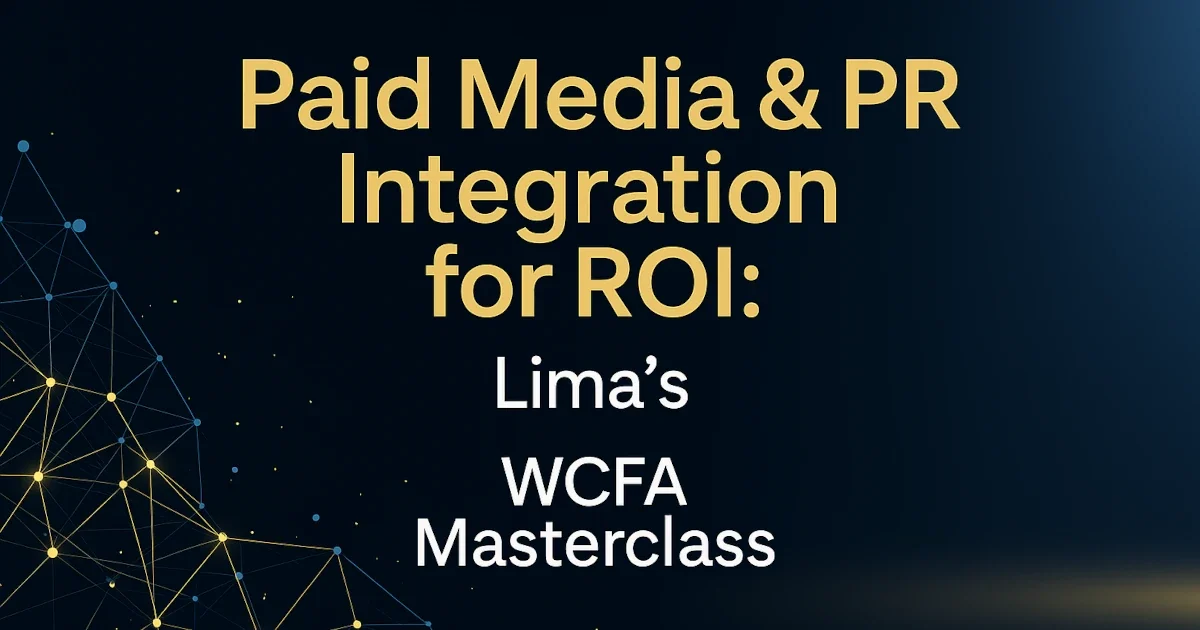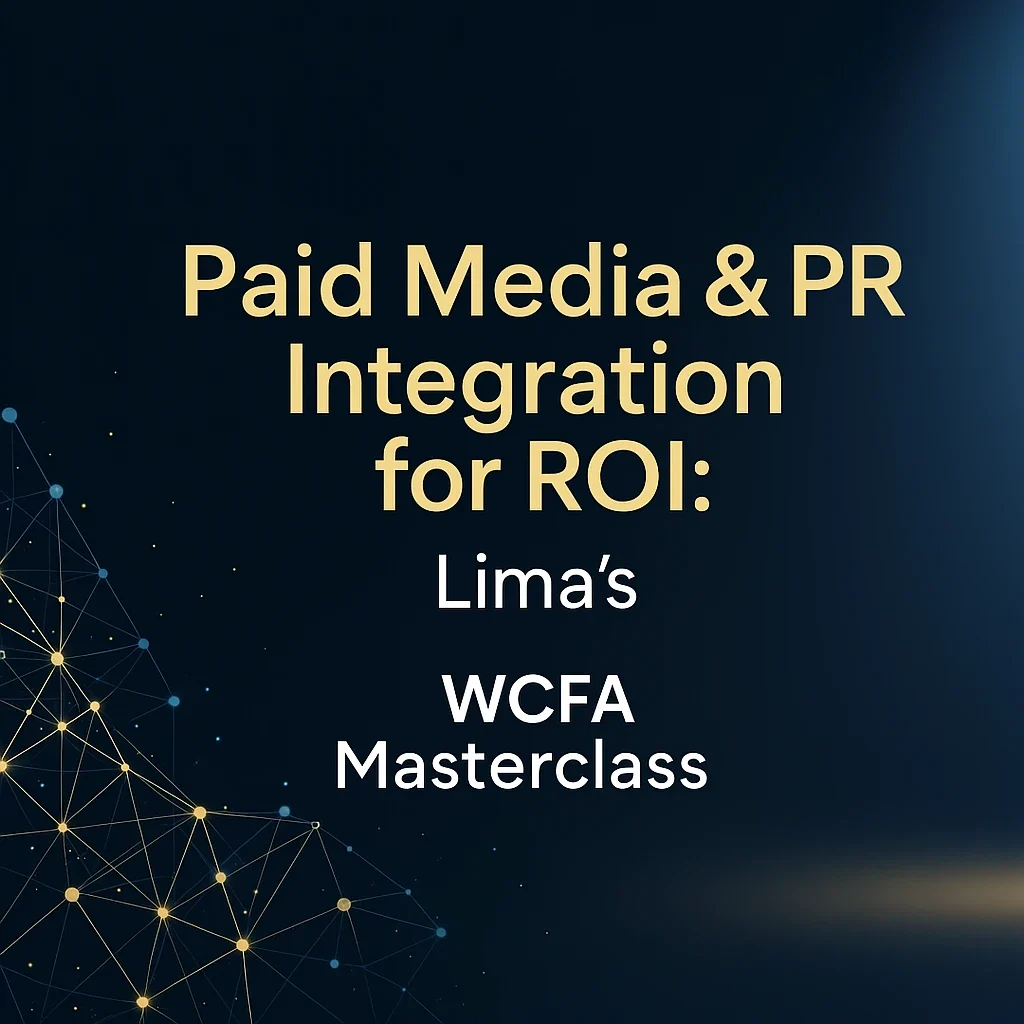
Last Thursday’s online masterclass was one of those rare sessions where you could feel the energy through the screen. Lima Alhawamdeh, our CEO, had the virtual room completely hooked as she unpacked the real mechanics of PR and paid media integration for the World Communications Forum Association.
The invitation came after her standout presentation at the WCFA Davos Communications Summit back in April. Her insights on these two disciplines clearly struck a chord then, and Thursday’s session proved why.
Why PR and Paid Media Integration Works
Here’s the thing: PR builds credibility, paid media amplifies it. Sounds straightforward enough. Anyone who’s tried to make this work in practice knows better.
Lima explained how these forces create something rather special when they work together properly. They don’t just shift perceptions, they drive genuine behaviour change. The kind that shows up in your monthly reports.
She opened with a question that stopped everyone cold: ‘What does success actually look like for you?’ It’s embarrassing how often this gets skipped. Coverage for coverage’s sake? Lead generation? Direct sales? Brand reputation over the long haul?
Without absolute clarity here, campaigns become expensive experiments with no real direction, and Lima’s seen plenty of those.
Getting the Foundations Right
Most marketers want to jump straight to the exciting bits. Platform selection, budget allocation, creative development. Lima took a different route entirely.
She spent considerable time on what she called ‘the boring groundwork that determines everything else.’ Brand positioning needs to be rock solid. Messaging must stay consistent across every touchpoint. You need to understand what your audience genuinely wants, not what you reckon they want.
This isn’t a marketing theory to tick off some checklists. Lima has witnessed too many well-funded campaigns collapse because they started from shaky foundations rather than poor execution. The money was there. The strategy wasn’t.
Creating Ad Content That People Trust
Lima’s creative philosophy turns the usual approach on its head. Polished, corporate content often feels hollow to modern audiences. People can smell manufactured authenticity from miles away.
Instead, she champions material that shows the human side of your brand. Behind-the-scenes moments consistently outperform boardroom glamour shots. Real customer testimonials beat scripted endorsements every time. Authenticity scales better than perfection, particularly in B2B markets where trust matters more than flash.
The strategy involves using paid channels to reinforce themes your PR efforts have already established. If your PR team’s been highlighting innovation, your advertising should echo that narrative. When you’ve built thought leadership around sustainability, your paid content needs to amplify those same messages.
Consistency across every touchpoint builds trust. Mixed messages destroy it faster than you’d think.
Platform Selection: Matching Tools to Goals
Lima cut straight through the usual industry jargon here. Meta’s Custom Audiences work brilliantly for reconnecting with people who’ve already engaged with your brand. LinkedIn Ads remain unbeatable when you need to reach specific decision-makers in B2B markets. Google Customer Match delivers excellent results with audiences who are actively looking to buy.
Her advice was refreshingly direct: stop trying to be everywhere at once just because the platforms exist. You’ll get much better results focusing your efforts on one or two channels rather than spreading thin across five.
Choose platforms based on where your objectives align with their strengths. Not the other way round.
The budget considerations here are the most important factors. Better to be competitive in one channel than achieve mediocrity across multiple touchpoints. Most agencies won’t tell you this because it doesn’t suit their billing models.
Audience Targeting: Beyond Demographics
This section challenged a few deeply held assumptions about targeting. Lima pushed hard against demographic-based approaches, and rightly so.
Age and location matter far less than behaviour and intent. Someone discovering your brand for the first time needs educational, story-driven content. Prospects evaluating solutions respond to proof points and social validation. Decision-stage audiences want urgency and clear next steps.
Understanding where people sit in this journey changes everything. Same product, identical budget, completely different outcomes based on how precisely you match content to intent.
Lima shared examples where simple audience refinements doubled conversion rates almost overnight. These weren’t major strategic overhauls, they were just smarter thinking about who sees what when.
Measuring What Matters
Lima was characteristically blunt about measurement. ‘Reach and impressions make pretty reports, but they don’t pay the bills.
She pushed hard for tracking metrics that connect directly to business outcomes. Qualified leads, inbound enquiries, meaningful media engagement, conversions that tie back to revenue. The stuff that truly matters when the board asks uncomfortable questions.
Her tool recommendations were specific and actionable. Meta Brand Lift Studies help track perception changes over time. Proper CRM integration enables lead attribution across multiple touchpoints. UTM parameters are true and tested for measuring campaign performance beyond vanity metrics.
You simply can’t run effective campaigns without these tools. They tell you whether your efforts are actually working or just generating impressive-looking dashboards.
Where Things Go Wrong
The discussion on common pitfalls proved equally valuable. Audience fatigue develops faster than most people anticipate, particularly in smaller markets. Message dilution across channels confuses prospects rather than convincing them. Over-targeting the same audience repeatedly inflates costs whilst diminishing returns.
Lima’s prevention strategies were elegantly simple. Refresh creative assets regularly to maintain engagement levels. Enforce consistency across all channels without exception. Manage audience overlap strategically to avoid internal competition between campaigns.
Simple concepts that deliver substantial improvements when implemented properly. The devil, as always, is in the details during the execution.
Real-World Case Studies
Two case studies brought theory into sharp focus. Tesla’s approach particularly fascinated the room. For years, they spent essentially nothing on paid media, relying instead on Elon Musk’s personal platform, earned PR coverage, and pure word-of-mouth. Zero social media ad spend, preferring influencer partnerships like that remarkable 2020 livestream with China’s Viya that pulled millions of views.
Now, here’s what’s interesting: in 2023-24, they quietly began testing paid digital campaigns. They reactivated their Facebook page after 6 years of absence and started running targeted ads on Meta platforms, namely Facebook and Instagram, but even YouTube to a lesser extent, to showcase models like the Model Y. On X, they launched paid campaigns that mirror Musk’s style, their first proper social media ad buys.
The success lies in their restraint. They’re still spending a fraction of what traditional automakers pour into advertising, but they’re amplifying existing momentum rather than creating it from scratch. Classic example of earned credibility enhanced through selective paid promotion.
Likewise, a HealthTech client working with AIWIZ provided an even more compelling example. Combining targeted PR with intelligent Google retargeting delivered a 40% reduction in cost-per-lead whilst tripling media engagement.
Tesla’s strategic amplification of PR coverage through Meta drove measurable brand perception shifts across international markets. The campaign succeeded because it amplified existing momentum rather than manufacturing interest from nothing. The transformation in both case studies came from smarter integration, not larger budgets. Better strategy beats relying on increased spending.
What Really Matters
Lima’s closing message was typical of her direct style: good strategy will outperform flashy tactics. Always.
Successful campaigns use paid media to amplify trust that PR efforts have already established. Every element should serve your audience’s actual journey, not an idealised version you’ve imagined in planning meetings.
Real ROI comes from campaigns that integrate from conception, maintain focus throughout execution, and remain genuinely audience-centric in their approach. The methodology isn’t revolutionary, but it demands consistent discipline.
Most agencies struggle with this because it requires genuine collaboration between teams who often work in silos.
A recording of the session will soon be available via the WCFA. Anyone serious about improving their marketing integration should make time to watch it. Lima’s insights tend to be worth considering.



